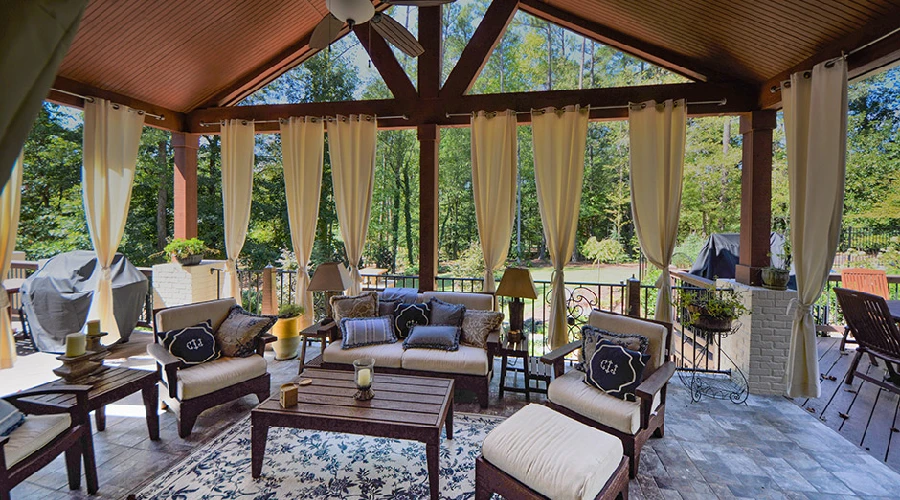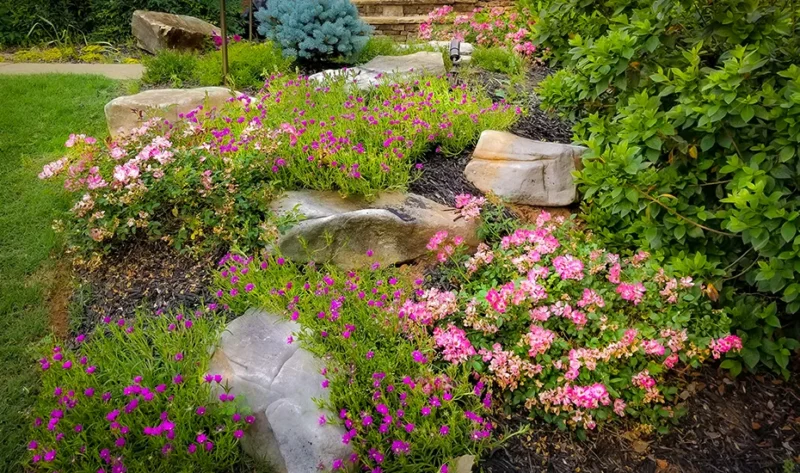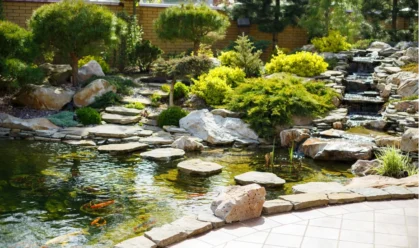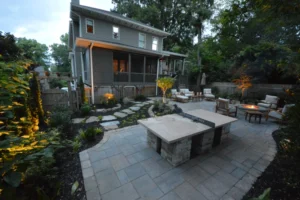When you invest in outdoor furniture, you’re not just purchasing a few pieces for occasional use—you’re investing in your outdoor comfort and accessories. Whether it’s for relaxing by the pool, hosting a barbecue, or simply enjoying Atlanta’s mild evenings, your outdoor furniture plays a significant role in your outdoor lifestyle. However, your investment can quickly deteriorate without proper care due to Atlanta’s unpredictable weather patterns.
Atlanta’s climate is known for its high humidity, intense summer heat, occasional thunderstorms, and, although mild, cold winter spells. Each season brings specific challenges that can take a toll on outdoor furniture if left unprotected. From the warping effects of humidity on wooden furniture to rust on metal pieces, it’s important to perform regular maintenance tailored to each season to ensure your furniture stays in top condition.
In this guide, we’ll cover essential Exterior decor ideas, material-specific care instructions, and long-term strategies to keep your outdoor furniture looking its best, year after year.
Summer: Protecting Furniture from Heat, Humidity, and Sun Damage
Summer in Atlanta can be unforgiving, with scorching temperatures, high humidity, and the ever-present threat of sudden thunderstorms. During these months, your outdoor furniture is exposed to a variety of environmental stresses, and proper care is crucial to prevent long-term damage.
Protecting Fabrics from UV Rays
The sun’s ultraviolet (UV) rays can do significant damage to outdoor fabrics, causing them to fade, weaken, and wear out much faster than they would in shaded or indoor environments. To protect your cushions and fabric furniture:
- Use UV-Protective Sprays: There are products designed to add an extra layer of UV protection to fabrics, helping to prevent fading and degradation.
- Store Cushions When Not in Use: On particularly hot days, or when you’re not using your outdoor furniture, it’s a good idea to bring cushions inside. Not only does this protect them from the sun, but it also prevents moisture buildup from summer storms.
- Invest in Sun-Protective Covers: Use breathable, UV-resistant covers for your furniture to shield both the frame and cushions from sun damage when not in use.

Preventing Mold and Mildew in Humid Weather
High humidity in Atlanta during the summer creates the perfect environment for mold and mildew growth, especially on cushions and wooden surfaces. Here’s how to prevent these issues:
- Keep Furniture Dry: After rain, make sure to wipe down any standing water on your furniture. Even a small amount of water can lead to mold growth in humid conditions. For wooden furniture, use a sealant that repels water to keep moisture out.
- Clean Regularly: Frequent cleaning helps keep mold and mildew at bay. For cushions, use a mixture of water and white vinegar to spot clean any mildew-prone areas. For wood, use a mold-resistant wood cleaner to maintain a clean surface.
- Store Cushions in Dry Places: If possible, bring cushions indoors or store them in a dry, ventilated space when not in use. Mold and mildew thrive in damp conditions, so keeping your cushions dry is the best way to prevent their growth.
Preventing Cracking and Fading on Wooden Furniture
Wood furniture requires extra attention during the summer to prevent cracking, fading, and warping due to sun exposure and moisture:
- Apply a Protective Sealant: Wooden furniture needs regular sealing to maintain its natural beauty and strength. Before the summer heat peaks, apply a protective coat of wood oil or sealant to guard against cracking and warping. This will also prevent water from penetrating the wood and causing rot.
- Use Shade When Possible: Place your wood furniture under a covered patio, pergola, or umbrella. Not only does this provide comfort during hot weather, but it also helps prevent UV damage to the wood.
- Rotate Furniture: If you can’t avoid sun exposure, try rotating your furniture periodically to ensure even wear and fading. This simple step can extend the life of your outdoor furniture significantly.
Managing Metal Furniture in Hot Weather
Metal furniture, especially darker colors, can absorb a lot of heat and become uncomfortable to use during the hot summer months. Here’s how to protect metal furniture during the summer:
- Invest in Cushions or Seat Pads: Not only will these keep you cooler, but they’ll also protect your skin from hot surfaces. Opt for cushions that are UV- and water-resistant.
- Inspect for Rust Frequently: The combination of humidity and heat in Atlanta can lead to rust formation on metal furniture, especially if there are any chips in the paint or protective coating. Regularly inspect for rust spots, sand them down, and apply a rust-inhibiting paint to protect the metal.
- Provide Shade or Cover: Similar to wooden furniture, it’s beneficial to provide shade for your metal pieces. If that’s not possible, consider using furniture covers when the furniture isn’t in use.
Fall: Prepping for Rain and Cooler Weather
As the heat of summer fades and Atlanta transitions into cooler fall temperatures, now is the time to prepare your outdoor furniture for the rainier, unpredictable weather of autumn. Fall is also a great opportunity to deep clean and refresh your furniture after the heavy use it likely saw during the summer months.
Cleaning After Summer Use
With summer in the rearview mirror, your outdoor furniture likely has accumulated a lot of dirt, dust, and perhaps even sunscreen residue. A thorough cleaning is a must before fall sets in:
- Wood Furniture: Give your wooden furniture a good scrub using a soft brush and a mild detergent. If your furniture is stained or heavily soiled, consider power washing it (at a low setting) and applying a fresh coat of sealant or protective oil afterward.
- Metal Furniture: Clean off any dirt or dust with a non-abrasive cleaner and inspect the surface for any signs of rust or corrosion. Sand down any rust spots and apply a protective primer and paint if needed.
- Wicker Furniture: Use a soft-bristle brush to remove dirt from the weaves and, if needed, wipe it down with a mild detergent solution. Let it dry thoroughly to prevent moisture from accumulating in the wicker.
- Fabric and Cushions: Launder any removable cushion covers and spot clean cushions to remove dirt and stains. Be sure to allow them to dry completely before placing them back outside, as damp cushions can quickly develop mildew in cooler weather.
Protecting Furniture from Rain
Fall in Atlanta brings cooler temperatures and an increase in rainfall. Your furniture will need extra protection from moisture to prevent water damage:
- Invest in Waterproof Covers: Fall rains can cause serious damage to outdoor furniture, especially wood, metal, and fabric pieces. Invest in high-quality, breathable covers that will protect your furniture from rain but also allow moisture to escape to prevent mold and mildew.
- Store Cushions and Fabrics Indoors: If you haven’t already, now is the time to bring your cushions inside when they’re not in use. Fall rain can leave cushions damp and prone to mold, which is difficult to clean.
- Elevate Furniture: If your patio or deck is prone to puddling after rainstorms, consider elevating your furniture on risers to keep it out of standing water.
- Reapply Protective Finishes: If you haven’t already done so, apply a fresh coat of wood oil or sealant to wooden furniture, and touch up any areas on metal furniture that may be prone to rust.
Dealing with Cooler Temperatures
As temperatures drop in the fall, your outdoor furniture materials will begin to contract, which can lead to warping, cracking, or breaking if they’re not properly maintained. Prepare your furniture for cooler temperatures by:
- Tightening Bolts and Joints: Cold weather can cause materials to contract, loosening bolts and joints. Before the weather gets too cold, tighten any loose screws or bolts to prevent wobbly furniture.
- Applying Wood Oil: Wood is particularly susceptible to expanding and contracting as the temperature fluctuates. Applying a coat of wood oil or sealant before the weather turns cold can help protect the wood from cracking.
- Storing Fragile Furniture: If you have plastic or wicker furniture, which can become brittle in cold weather, consider storing it in a shed or garage to protect it from the elements.
Winter: Storing and Protecting Furniture from Frost and Freezing Conditions
While Atlanta winters are milder compared to other regions, freezing temperatures and frost can still cause damage to outdoor furniture, especially if it’s left exposed to the elements. Taking the time to properly store and protect your furniture in winter will save you time and money in repairs or replacements when spring comes around.
Proper Storage Techniques for Winter
If you have the space, storing your outdoor furniture in a garage, shed, or basement is the best way to protect it from the cold and moisture during winter. However, if indoor storage isn’t an option, here’s how to protect your furniture outdoors:
- Use Weatherproof Covers: Invest in durable, weatherproof covers that fit snugly over your furniture. Look for covers that are water-resistant and breathable to prevent moisture buildup underneath.
- Stack or Fold Furniture: If your furniture is foldable or stackable, doing so will help protect it from the elements and save space. Stack chairs and fold tables to minimize exposure to rain and frost.
- Elevate Furniture: Keeping your furniture off the ground can prevent moisture from seeping into the legs and causing rot or rust. Use risers or place furniture on a covered patio if possible.
Protecting Wooden Furniture from Cold Damage
Wooden furniture is particularly vulnerable to freezing temperatures, which can cause the wood to crack or split. Here’s how to protect wood furniture during winter:
- Apply a Protective Sealant: Before the temperature drops, apply a water-repellent sealant to prevent moisture from penetrating the wood. This will also protect it from expanding and contracting as temperatures fluctuate.
- Cover or Store Indoors: If possible, move your wooden furniture indoors for the winter. If that’s not an option, make sure it’s covered with a waterproof, breathable cover to keep out rain and frost.
- Avoid Placing Directly on Soil: If your wooden furniture is on a grassy or soil-based area, move it onto a hard surface like a patio or deck to prevent moisture from the ground seeping into the wood.
Preventing Metal Furniture from Rusting
Metal furniture can rust when exposed to cold, wet conditions for an extended period. Here’s how to protect it during the winter months:
- Apply a Rust-Resistant Coating: Before winter sets in, inspect your metal furniture for any signs of rust or corrosion. Sand down any rust spots and apply a rust-resistant primer followed by paint or sealant to protect it from future damage.
- Use Waterproof Covers: Even if your metal furniture is rust-resistant, it’s still a good idea to cover it during the winter to protect it from moisture.
- Store Small Metal Pieces Indoors: For smaller items like metal side tables or chairs, consider moving them indoors during the winter to prevent rust from forming.
Taking Care of Fabrics and Cushions
Cushions and fabric pieces should be stored indoors during the winter to protect them from cold, moisture, and potential mold growth. Follow these tips to keep your fabrics in good condition:
- Clean and Dry Before Storing: Before packing away your cushions for the winter, make sure they are clean and completely dry to prevent mold and mildew. Launder cushion covers and spot-clean any stains before storage.
- Store in a Dry, Cool Place: Keep your cushions and fabrics in a dry, cool place to avoid moisture buildup. Use plastic bins or breathable fabric bags to store them safely until spring.
Spring: Prepping Your Outdoor Furniture After Winter
As the cold of winter fades and Atlanta transitions into spring, it’s time to give your outdoor furniture the attention it needs to prepare for the warmer months ahead. Spring cleaning is a necessity—not just for your home but for your outdoor space as well. This is the ideal time to inspect, clean, and prepare your furniture for the upcoming months of regular use.

Cleaning After Winter Storage
After months of winter, your outdoor furniture might be dusty, dirty, or even moldy if it was exposed to moisture. Even if you stored your furniture properly, it’s essential to give it a thorough cleaning before it sees any use.
- For Wood Furniture: Use a mixture of mild soap and water, or a specialized wood cleaner, to gently scrub away dirt. Make sure to rinse the wood thoroughly to avoid leaving soap residue, which can attract dirt. If your wood furniture appears faded or weathered, consider lightly sanding the surface and applying a fresh coat of wood oil or sealant to protect it from the elements.
- For Metal Furniture: Check for any signs of rust or corrosion. If rust is present, sand it down with fine-grit sandpaper and apply a rust-resistant primer followed by paint to restore the surface. For cleaning, use a non-abrasive cleaner to wipe down metal surfaces, making sure to dry them off completely to prevent future rusting.
- For Wicker Furniture: Wicker (whether natural or synthetic) can accumulate dust in its weaves, so use a soft brush or vacuum cleaner to remove dirt from tight crevices. If needed, wipe it down with a mixture of water and a gentle detergent. Allow it to dry completely before placing cushions back on the furniture.
- For Plastic Furniture: Plastic is prone to fading, but a good cleaning can restore its shine. Wipe it down with soapy water and a soft cloth. For tougher stains, you can use a mixture of baking soda and water for a deeper clean.
Inspecting for Damage from Moisture and Cold
Winter moisture can cause damage that isn’t always immediately visible. Now’s the time to inspect your furniture closely:
- Look for Cracks or Splits: Wooden furniture is especially vulnerable to cracking and splitting if it was exposed to freezing temperatures. Check for small cracks or weakened joints, and repair them as needed to prevent further damage.
- Check Metal for Rust: Metal furniture may develop rust during the cold, wet winter months. Sand down rust spots and apply a rust-preventive primer and paint to protect it from future corrosion.
- Inspect Fabrics and Cushions: If your cushions and fabrics weren’t stored indoors, they may have accumulated moisture, dirt, or mildew. Wash them according to the manufacturer’s instructions and check for any tears or wear. Replace any cushions that are too worn to ensure maximum comfort and durability throughout the warmer months.
Preparing Cushions and Fabrics for Use Again
If you stored your cushions and outdoor fabrics inside during the winter, now’s the time to bring them back out. Launder any machine-washable cushions and air out non-washable pieces to remove any musty smells. For cushions that were exposed to the elements, check for signs of mildew or fading. If the fabric looks worn, consider replacing it with UV-resistant and water-repellent materials for the upcoming summer.
Caring for your outdoor furniture in Atlanta’s unique climate requires a bit of effort, but the rewards are well worth it. By following these seasonal maintenance tips, you can keep your outdoor furniture looking great and functioning properly for years to come.
Whether it’s the intense summer heat or the cooler, wetter months, with a little preparation and care, your outdoor living space will remain a comfortable and beautiful extension of your home throughout every season.






























